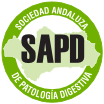CORRESPONDENCIA
Enrique de Madaria Pascual
Dr. Balmis General University Hospital. Alicante.
03010 Alicante
CITA ESTE TRABAJO
Guilabert L, de-Madaria E. Initial management of acute pancreatitis. RAPD 2024;47(6):207-211. DOI: 10.37352/2024476.1
Introduction
Acute pancreatitis (AP) is a common disease that represents one of the leading causes of hospitalisation for gastrointestinal disorders, with significant associated costs and an increasing incidence[1]. Although most cases have a mild course, about one third of patients develop local complications or organ failure, which worsens the prognosis[2].
This article provides an evidence-based approach to the initial management of AP, addressing also the aetiological evaluation to prevent recurrences.
Early prognosis
After the initial diagnosis of AP, it is critical to assess the risk of the patient developing moderately severe or severe forms of the disease, which will guide treatment strategies. Factors such as obesity, advanced age and elevated blood urea nitrogen (or urea) and haematocrit have been associated with poor outcome[3],[4]. Although multiple severity prediction systems exist, none have demonstrated clear superiority over others, and their positive predictive value is often limited[3].
Fluid therapy
Fluid therapy has been considered one of the mainstays of treatment in the early phase of AP. Traditionally, it has been believed that aggressive fluid replacement could improve blood flow to the pancreas, thereby reducing the risk of pancreatic necrosis[5]. However, recent studies, including our group's WATERFALL clinical trial, suggest that a moderate fluid therapy strategy (1.5 ml/kg/h and a bolus of 10 ml/kg in case of hypovolaemia), offers better results than aggressive fluid therapy, reducing fluid overload and associated complications [6],[7]. Lactated Ringer's solution appears to be preferable to normal saline due to its anti-inflammatory properties[8].
Pain management
Pain is one of the most relevant symptoms in AP, significantly impacting patient experience. Opioids are commonly used due to their potent analgesic effect, although their use has been associated with worsening disease severity in some studies[9]. This result may be biased, as the most severe cases are those most frequently receiving opioids. Other alternatives such as non-steroidal anti-inflammatory drugs (NSAIDs) have been shown to be equally effective in controlling pain during the first 24 hours[10]. In a pilot study by our group, metamizole tended to be more effective than morphine, but the sample size was very small[11]. Epidural anaesthesia may be an effective option in cases of uncontrolled pain in intensive care units[10]. Finally, COX-2 inhibitors may have beneficial effects on disease progression[12].
Early nutrition
Historically, it was believed that ‘pancreatic rest’, avoiding oral food intake, was essential in the treatment of AP in order to prevent pancreatic enzyme stimulation and secretion. However, recent studies have challenged this belief. Numerous randomised clinical trials in good prognosis pancreatitis have shown that early feeding, even with a solid or soft diet, is safe and associated with a reduction in length of hospitalisation and costs, without increasing rates of oral intolerance or complications[13]. Evidence shows that it is not necessary to start with a liquid diet and gradually progress to solid foods but that early introduction of a solid or soft diet is well tolerated and shortens hospital stay[13]. In patients with severe or moderate pancreatitis, who cannot tolerate oral feeding, enteral nutrition is still useful, but in patients who tolerate oral intake, it does not change the course of the disease and its widespread use should be avoided[14]. In the absence of duodenal stenosis, there is no advantage for the use of nasojejunal tube nutrition over nasogastric tube nutrition[15],[16]. Parenteral nutrition should generally be avoided in favour of oral nutrition, or enteral if not tolerated[17], as it is associated with poorer outcomes. The use of immunonutrients, such as L-glutamine and omega-3 fatty acids, requires further evaluation in larger studies to establish their true benefit in patients with AP. While some preliminary studies suggest potential benefits, heterogeneity in results and small sample sizes have limited the generalisability of immunonutrient use. In particular, probiotics, once considered a possible treatment option, have been shown to be potentially dangerous in patients with severe AP, with increased mortality[18].
Antibiotic use and antifungal therapy
The use of antibiotics in AP is a controversial issue due to their overuse. While some patients may benefit from their use in cases of confirmed or suspected infection, prophylactic administration of antibiotics in AP without evidence of infection has been shown to be ineffective. Several meta-analyses have concluded that prophylactic use does not reduce the incidence of infected necrosis or improve other clinical outcomes[19].
Deciding when to administer antibiotics in patients with AP who present with signs of inflammation, such as fever or leukocytosis, but without clear evidence of infection, remains a clinical challenge. In these cases, the use of the bacterial infection marker procalcitonin (with a cut-off point of 1 ng/ml) has been proposed as a useful tool to guide the decision to start or stop antibiotics, thus reducing unnecessary antibiotic use without compromising patient safety[20].
In terms of antifungal therapy, fungal infections, such as invasive candidiasis, can develop in patients with necrotising AP, particularly those patients in the intensive care unit who require central venous catheters, parenteral nutrition or broad-spectrum antibiotics. However, antifungals should also not be administered prophylactically; their use should be reserved for confirmed fungal infections[21].
Endoscopic retrograde cholangiopancreatography (ERCP)
Studies suggest that early ERCP in patients with cholangitis is associated with a significant reduction in hospital mortality, 30-day mortality, organ failure and length of hospital stay[22]-[24].
However, the use of early ERCP (first 24-48h) in patients with biliary AP without cholangitis has been a matter of debate. Several randomised clinical trials have shown that early ERCP does not improve clinical outcomes in these patients, even in those with gallstones or gallbladder sludge[25]-[27]. Therefore, early ERCP should be reserved for those with suspected cholangitis. In the presence of choledocholithiasis, it is common sense that should guide when to perform ERCP, as no study has shown it to be harmful either.
Aetiological assessment
Identifying the cause of AP is essential to prevent recurrent episodes. Biliary aetiology is the most common cause, responsible for approximately 60% of cases[2]. Abdominal ultrasound has limited sensitivity for the diagnosis of gallbladder biliary sludge, so in the absence of biliary lithiasis or other aetiologies in the ultrasound, it is recommended to perform an endoscopic ultrasound, as it allows diagnosis, in addition to accurately assessing the pancreatic parenchyma and its ductal system. In cases of mild biliary AP, cholecystectomy during the same hospital admission is more effective in preventing relapses and gallstone-related complications compared to delayed cholecystectomy[28]. In cases of AP with collections/necrosis, it is recommended to delay cholecystectomy until local complications are controlled, usually 4-6 weeks after the initial episode[28],[29]. Imaging tests will give an idea of the regression of collections so that the patient can be operated on.
Another important cause of AP is alcohol consumption, which accounts for 15-20% of cases[2],[30]. Approximately 50% of patients who continue to consume alcohol after an episode of AP will have recurrences, whereas abstinence significantly reduces this risk[31]. Repeated interventions to promote abstinence from alcohol, even after discharge, have been shown to be more effective than single interventions during hospitalisation[32].
Hypertriglyceridaemia (HTG) is a less common cause of AP in Western countries, accounting for 2-5% of cases, although in countries such as China, its prevalence is much higher[33]. Triglyceride levels above 1000 mg/dL are usually required to induce an episode of AP[33]. HTG-induced AP has been shown to be associated with a worse prognosis and increased risk of recurrence[33],[34].
The initial management of AP due to HTG is similar to that of other aetiologies. However, in these patients it may be necessary to prolong fasting to reduce triglyceride levels. In addition, the use of insulin and plasmapheresis have been used as strategies to lower triglycerides, although the evidence supporting these treatments in terms of improving clinical outcomes is limited, and even plasmapheresis may be detrimental[35],[36]. To avoid recurrences, it is essential to implement changes in diet, lifestyle and the use of lipid-lowering drugs, with the aim of keeping triglyceride levels ideally below 200 mg/dL[37].
Conclusions
The initial management of acute pancreatitis continues to evolve, with new evidence challenging previous practices and influencing current clinical strategies. Current tools for predicting disease severity remain imperfect; modest goal-directed fluid therapy has replaced aggressive strategies due to the detrimental outcomes associated with the latter. Effective pain control and early oral nutrition are essential components in the management of AP. The use of antibiotics and antifungal therapies should be limited to cases with proven or highly suspected infections, avoiding their prophylactic use. Procalcitonin has been proposed as a useful tool to decide when to start or stop antibiotics. Early ERCP should be reserved for cases of acute cholangitis, and the aetiology of AP should be addressed to prevent relapse. Same-admission cholecystectomy in cases of mild biliary AP may reduce disease recurrence.


 Descargar número completo
Descargar número completo Download full issue
Download full issue